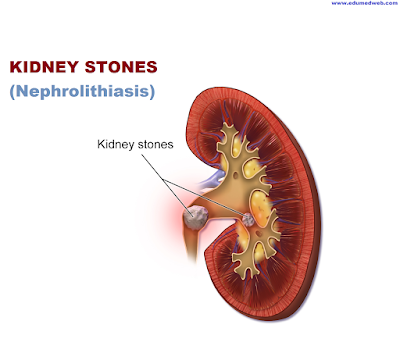Kidney Stones
Kidney Stones
Classification
|
Types
|
Constituents
|
Seen In
|
||
|
Calcium Based Stones
|
Calcium Oxalate/ Calcium Phosphate
|
Radiopaque
|
Most Common Kidney Stone
|
Hypercalcemia, Hypercalciuria And Hyperoxaluria
|
|
Uric Acid Stones
|
Uric Acid
|
Radiolucent
|
Most Common Radiolucent Kidney Stone
|
Gout, Lesch-Nyhan Syndrome & Myeloproliferative Disorder
|
|
Struvite Stones
|
Magnesium, Ammonium & Phosphate
|
Radiopaque
|
Staghorn Calculi
|
Develop In Alkaline Urine associated with Urea-splitting organism (e.g., Proteus, Klebsiella)
|
|
Cystine Stone
|
Cystine
|
Intermediate Radiolucency
|
Hexagonal Crystals
|
Cystinuria
|

Clinical Presentation
|
Clinical Presentation
|
|
Most of the patients are Asymptomatic
|
|
Most common symptom is Renal or Ureteric colic
|
|
Costovertebral angle pain or Flank pain which can radiate to the Scrotum or Labia
|
|
Hematuria
|
|
Location of Stones
|
Pain radiates to
|
|
Pelvis/ Upper third of Ureter
|
Testis
|
|
Middle third or Ureter
|
Iliac fossa
|
|
Lower third of Ureter
|
Inner aspect of Thigh, Scrotum or Perineum
|
Imaging
|
Imaging
|
|
A Plain X-Ray KUB may reveal the Radiopaque stones.
|
|
Investigation of choice to diagnose Acute Ureteric colic is NCCT.
|
Treatment
|
Conservative management
|
|
|
1.Hydration (Plenty of fluids) to increase Urine output
|
|
|
2.Analgesia
|
|
|
Indication of Conservative management
|
Stone Size ≤ 5mm
|
|
Non-Dilated pelvicalyceal system
|
|
|
Stone In Distal third Of Ureter
|
|
|
Downward movement of stone on Repeated scan
|
|
Interventions For Renal Stones
|
Interventions For Renal Stones
|
|
|
1.ESWL (Extracorporeal Shock Wave Lithotripsy)
|
Curative in 85 % cases
Useful for stones up to 2cm
Contraindications: Pregnancy, Bleeding disorder
|
|
2.PSNL (Percutaneous Nephrolithotomy)
|
Indicated in stones > 2cm, ESWL Failure
|
|
3.URS (Ureterorenoscopy)
|
Ureteric stones
|
|
4.LSS (Laparoscopic Stone Surgery)
|
|
|
5.OSS (Open Stone Surgery)
|
|
Prevention
|
Prevention of Stones
|
|
1.Maintenance of high urine output (2 to 3 L/d) With Oral Hydration
|
|
2.Low-Salt diet (<2 g/d)
|
To download Urology (Surgery) Handwritten Notes for NEET PG, AIIMS, UPSC CMS & Other PG medical entrance exams CLICK HERE
Contents of this Handwritten Notes
1. Kidney & Ureter
2. Urinary Bladder
3. Prostrate
4. Penis & Urethra
5. Testis & Scrotum
» This post is written for the purpose of solving MCQs. Not for other use
|
Thank you Reader
|
|
Your Like Motivate Us To Post New And Unique Articles So Don’t Forget To Like, Comment and Share This Post. LIKE US On Our Facebook Page To Get Latest Updates.
|

![[PDF] Everything about UPSC CMS](https://edumedweb.com/wp-content/themes/ribbon-lite/images/nothumb-related.png)